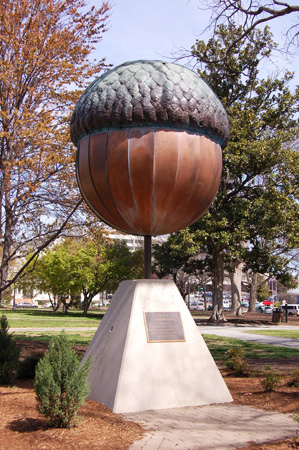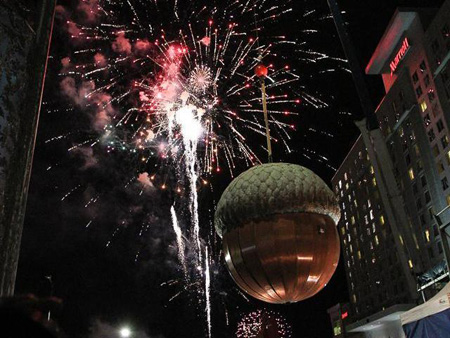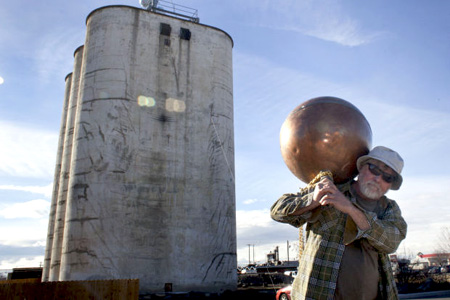Ringing in the New Year with Copper
 Thousands gather in Raleigh every year to watch the copper acorn drop on New Year's Eve.
Thousands gather in Raleigh every year to watch the copper acorn drop on New Year's Eve.Photo courtesy of David Benson.
When sculptor David Benson was commissioned to create a gigantic acorn out of copper for the city of Raleigh, North Carolina, he didn’t realize the full impact it would have on his life.
“It was just a job at the time,” he says. “I just wanted to pay my phone bill.”
But the businessman behind the project, who was also a friend and neighbor to Benson who brought him on board for the task in 1991, thought otherwise.
“He said it was going to make me famous,” Benson says, referring to the late John Watkins. “Sure enough, it made me famous. I guess it’s the piece everybody knows me for.”
The project evolved from the city’s desire to have a monument to commemorate its bicentennial. Known as the “City of Oaks”, it was deemed an acorn would be an appropriate symbol.
“I built it and then we dropped it for New Year’s to bring in the bicentennial for the city of Raleigh,” he says.
Every year since, Benson has been involved with the acorn drop that 30,000 to 40,000 people come out to witness. It also gives him the opportunity to give the sculpture some routine maintenance.
“I polish it and we take a big crane and lift it up and have a spot where we lower it,” he says. “I keep the natural patina on top and just polish the bottom half. We keep it really shiny.”
Benson enjoys his continuous involvement in keeping up the acorn.
“It keeps me involved in the city and that’s what it’s all about,” he said. “I usually drop it. I get front row seats. It’s a lot of fun.”
The decision to drop the ball annually in downtown Raleigh had an impact on the design of the 8.5’ tall acorn that is 8’ in diameter and weighs 1,250lbs.
“I designed it so we can drop it every year and put it on a pedestal in the park,” Benson says, referring to the ability he has to take it on and off the pedestal with ease.
Initially, Benson proposed making the acorn out of stainless steel, but says he realized it would have posed too much difficulty in carrying out the task.
“We came up with copper because of its natural color. It has a beautiful patina and it is very organic looking,” he says.
 The copper acorn in Moore Park, on diplay the rest of the year.
The copper acorn in Moore Park, on diplay the rest of the year.Photo courtesy of David Benson.
Creating an acorn of this size certainly came with its own set of challenges. Benson researched how other large scale projects were created, and in the end, decided to create a hollow structure out of mild steel and cover it with copper sheeting.
“The Statue of Liberty was pretty much created the same way,” Benson says. “It has a steel understructure and is covered with hammered copper sheets.”
He was also inspired by a particular fruit.
“I thought of an orange because it has sections. I divided the acorn into twenty sections to give it the look of it being round and smooth. Then, I used flat sheets to rivet and screw the copper onto a steel frame,” Benson says. “
The copper covering th acorn also has great sentimental value. Benson was given a piece of copper that he believes was taken off Raleigh’s capitol building’s dome at one time when it was redone. “A piece was laying around in the archives,” he says.
Benson was no stranger to working with copper prior to taking on the acorn sculpture. After working with several metals over the past few decades, copper remains one of his favorite mediums.
“It’s malleable,” he says. “You can heat it up to get beautiful colors. You can put patinas on it and you can polish it. It’s durable and doesn’t corrode like steel,” he says. “Copper is the next best thing to stainless.”
The acorn project took Benson a few months to complete, and required input from many different angles.
“First, I designed it. Then, I made a small clay model, which I gave to the guy who hired me to do it,” he said. “There were a lot of meetings. I met with City Council, the mayor.”
Given its home in historic Moore Square, Benson also involved others in his project.
“I had structural engineers and architects look at it,” he says. “It’s in the public and above people’s heads so it has to be safe.”
After Benson completed the sculpture, now considered the symbol of Raleigh, people began sending him souvenirs.
“Chocolate acorns arrived on my doorstep,” he says. “I even got a pair of glow-in-the-dark underwear with acorns on it that said, ‘I’m nuts for you’,” he says.
Over the years, Benson has had to repair the sculpture on occasion.
 The copper acorn is a focal point of Raleigh, North Carolina on New Year's Eve.
The copper acorn is a focal point of Raleigh, North Carolina on New Year's Eve.Photo courtesy of David Benson.
“Water gets in and drains out. Leaves build up inside – they get in the little cracks between the sheeting,” he says, adding other reasons the sculpture has needed his attention. “We had a tornado which damaged it.”
Most of Benson’s professional life is currently dedicated to running the Third Place coffeehouse in Raleigh, which he owns. It also serves as a gallery.
“I have an art show retrospective of my work at the coffee shop,” he says of the current exhibition on view.
Raleigh isn’t alone in ringing in the New Year with copper.
In the 90’s, Dave Woodhead, who lives in Twin Falls, Idaho, spotted a large, hollow, copper ball at an auction that he ended up buying for about $20.
“I just liked its looks and had no idea what I was going to do with. Nobody knows what it is probably used for,” he says. It looks partly handmade. It definitely has a purpose and we have no idea what it is. Its salvage value would probably exceed what I paid for it.”
In 2002 he opened up Woody’s Bar and Grill which brought his attention back to the copper ball.
“I got the idea to drop it because there is a silo nearby you can see from the bar,” he says. “We thought that it would be neat to drop a ball from there. I have just always thought the ball drop in NYC was pretty cool.”
That year, he, along with his friend, Earl Mitchell, didn’t tell anyone and just did it for the fun of it.
“We thought it was a great idea and kept doing it except for 2013 due to closing the bar,” he says.
Initially they would run toward the silo while holding a rope to let the ball fall down using a pulley system they rigged.
“Then we got the idea of hooking it up to my pickup truck,” Woodhead says. “It’s kind of nice to use because the pick-up is a 1961 Ford Econoline, so it kind of adds to the whole circus atmosphere kind of thing.”
Woodhead and Mitchell have to contend with the 80 foot height of the silo annually.
“We have to climb five spiral staircases to get up there and get our rigging right,” he says. “We have a pipe up there with a pulley on it and we stick it through a window and put the rope through that and attach one end to the ball and the other end to the pickup.”
 Dave Woodhead carries the copper ball he bought at an auction that is a focal point of New Year's Eve in Twin Falls when the ball is dropped from the silo shown behind him.
Dave Woodhead carries the copper ball he bought at an auction that is a focal point of New Year's Eve in Twin Falls when the ball is dropped from the silo shown behind him.Photo courtesy of Dave Woodhead.
Now about 200 people turn out annually to see a spotlight illuminating Woodhead’s copper ball as it makes its way down the silo.
Woodhead is proud his ball drop is acknowledged in a Wikipedia writeup listing objects dropped in America on New Year’s Eve by state.
“When I looked at the Wikipedia, it turns out people drop all kinds of things all over the place,” he says. “Some of them are kind of ridiculous.”
This year, the owner of Hometown Sports Bar and Grill that occupies the space where Woodhead’s bar and grill used to be, looks forward to ringing in the New Year given his prime location for patrons to view the ball drop.
“We are going to have four bands that night at the bar and the ball dropping ceremony,” says Johnny Aslett, Hometown’s owner. “It is kind of like an icon for Twins.”
Resources:
Also in this Issue:
- Ringing in the New Year with Copper
- Brass Adds Warmth to Contemporary Judaica Art
- Copper’s Part in Star-Lite Stained Glass
- Copper Lifetime Art Forms, Completely Handcrafted in Louisiana
- Liz Glynn’s The Myth of Singularity, Bronze Exhibit on View at LACMA
